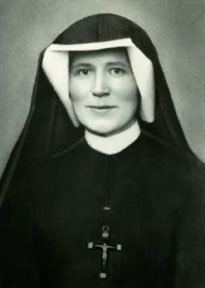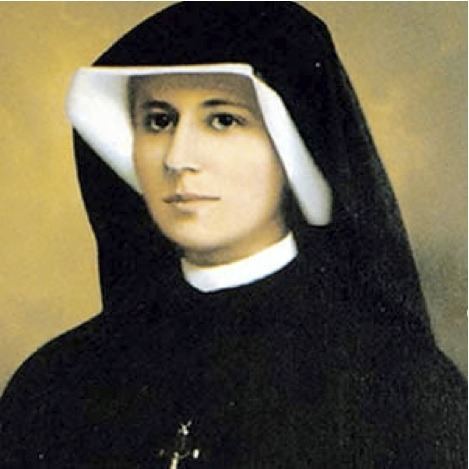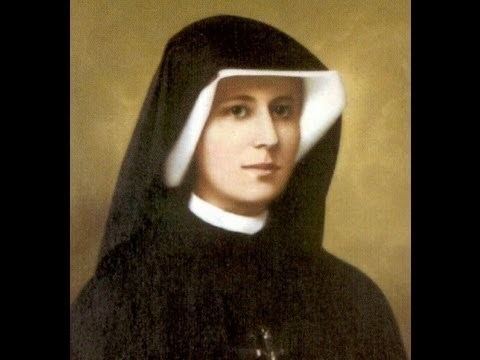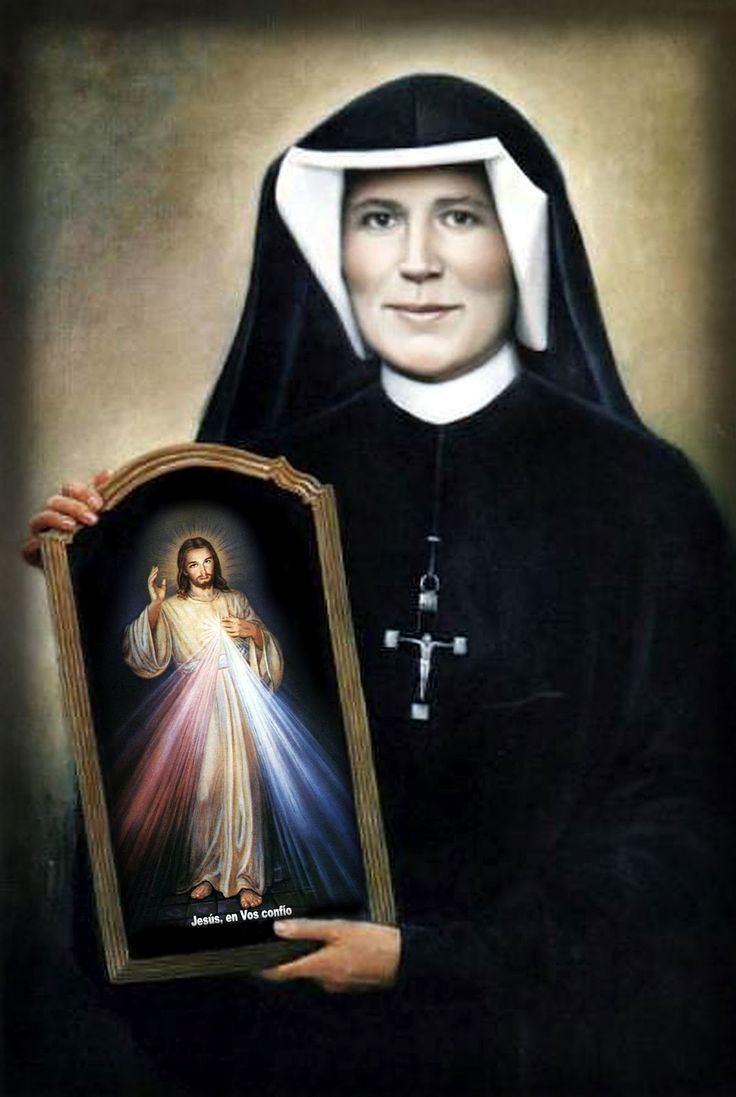Beatified April 18, 1993 Role Religious sister | Feast 5 October Movies Faustina | |
 | ||
Parents Marianna Kowalska, Stanislaus Kowalski Similar People Michal Sopocko, Maximilian Kolbe, Jerzy Lukaszewicz, Stanislaus of Szczepanow, Jadwiga of Poland | ||
Died 5 October 1938 (aged 33) Kraków, Second Polish Republic Born 25 August 1905 (age 33) Głogowiec, Łęczyca County, Congress Poland, Russian Empire | ||
Saint faustina kowalska the great warning previous to the christ s return parousia
Saint Maria Faustyna Kowalska of the Blessed Sacrament, OLM, popularly spelled Faustina (born as Helena Kowalska; 25 August 1905 in Głogowiec – 5 October 1938 in Kraków, Poland), was a Polish Roman Catholic nun and mystic. Her apparitions of Jesus Christ inspired the Roman Catholic devotion to the Divine Mercy and earned her the title of "Apostle of Divine Mercy".
Contents
- Saint faustina kowalska the great warning previous to the christ s return parousia
- Heaven diary of st faustina kowalska on life after death
- Childhood and early years
- Joining the convent in Warsaw
- Pock and the image of Divine Mercy
- Vilnius meeting Father Sopoko
- Krakw the final years
- Spread of the devotion
- Sainthood
- References

Throughout her life, Faustina reported having visions of Jesus and conversations with him, of which she wrote in her diary, later published as The Diary of Saint Maria Faustina Kowalska: Divine Mercy in My Soul. Her biography submitted to the Congregation for the Causes of Saints quoted some of these conversations with Jesus regarding the Divine Mercy devotion.

At the age of 20 years she joined a convent in Warsaw, Poland, was later transferred to Płock, and then to Vilnius where she met her confessor Father Michał Sopoćko, who supported her devotion to the Divine Mercy. Faustina and Sopoćko directed an artist to paint the first Divine Mercy image, based on Faustina's vision of Jesus. Sopoćko used the image in celebrating the first Mass on the first Sunday after Easter. Subsequently, Pope John Paul II established the Feast of Divine Mercy on that Sunday of each liturgical year.

The Roman Catholic Church Canonized Faustina as a saint on 30 April 2000. The mystic is classified in the liturgy as a virgin and is venerated within the Church as the "Apostle of Divine Mercy".

Heaven diary of st faustina kowalska on life after death
Childhood and early years
She was born as Helena Kowalska, in Głogowiec, Łęczyca County, north-west of Łódź in Poland. She was the third of ten children of Stanisław Kowalski and Marianna Kowalska. Her father was a carpenter and a peasant and the family was poor and religious.
She stated that she first felt a calling to the religious life while attending the Exposition of the Blessed Sacrament at 7 years of age. She wanted to enter the convent after completing her time at school, but her parents would not give her permission. When she was 16 years old, she went to work as a housekeeper first in Aleksandrów Łódzki where she received the Sacrament of Confirmation then in Łódź, to support herself and help her parents.
Joining the convent in Warsaw
In 1924 at the age of 19 years, Faustina and her sister Natalia went to a dance in a park in Łódź. Faustina said that while at the dance she had a vision of a suffering Jesus. She then went to the Cathedral, where, she said, Jesus instructed her to depart for Warsaw immediately and join a convent. She packed a small bag that night and took a train for Warsaw (85 miles away) the next morning, without the permission of her parents and without knowing anyone in Warsaw. After she arrived, she entered the first church she saw (Saint James Church in Warsaw) and attended Mass. She asked the priest, Father Dąbrowski, for suggestions and he recommended staying with a Mrs. Lipszycowa, a local woman whom he considered trustworthy, until she found a convent.
Faustina approached several convents in Warsaw, but was turned down every time, in one case being told that "we do not accept maids here", referring to her poverty. Faustina could read and write and had three or four years of education. After several weeks of searching, the mother superior at the convent of Zgromadzenie Sióstr Matki Bożej Miłosierdzia (Congregation of the Sisters of Our Lady of Mercy) decided to give her a chance and conditionally accepted her, provided that she could pay for her religious habit. Faustina knew nothing of the convent she was entering, except that she believed she was led there.
In 1925, Faustina worked as a housemaid to save money, making deposits at the Convent throughout the year, and finally gained acceptance. On 30 April 1926 at the age of 20 years, she received her habit and took the religious name of Sister Maria Faustina of the Blessed Sacrament. The name "Faustina", a diminutive of Fausta, which means "fortunate" or "lucky". Richard Torreto sees it as the feminine form of the name of a Roman martyr Faustinus, killed in AD 120. Faustinus and Jovita. However, the Roman Martyrology lists a Saint Faustina of about AD 580 and two ancient saints (as well as four modern ones) called Faustinus, assigning the Roman martyr to the third or fourth century, while the other is the Faustinus associated with Jovita. In April 1928, she took her first religious vows as a nun with her parents attending the profession rite. She was a nun for a little more than a decade, and died at the age of 33 years on 5 October 1938.
From February to April 1929, she was sent to the convent in Wilno, then in Poland, now Vilnius, Lithuania, as a cook. Although her time in Vilnius was short, she returned there later and met Father Michael Sopoćko, who supported her mission. A year after her first return from Vilnius, in May 1930, she was transferred to the convent in Płock, Poland for almost two years.
Płock and the image of Divine Mercy
Faustina arrived in Płock in May 1930. That year the first signs of her illness (which was later thought to be tuberculosis) appeared and she was sent to rest for several months in a nearby farm owned by her religious order. After recovery she returned to the convent and by February 1931 had been in the Płock area for about nine months.
Faustina wrote that on the night of Sunday, 22 February 1931, while she was in her cell in Płock, Jesus appeared to her as the "King of Divine Mercy" wearing a white garment with red and pale rays emanating from his heart. In her diary (Notebook I, items 47 and 48) she wrote that Jesus told her:
Paint an image according to the pattern you see, with the signature: "Jesus, I trust in You" (in Polish: "Jezu, ufam Tobie"). I desire that this image be venerated, first in your chapel, and then throughout the world. I promise that the soul that will venerate this image will not perish.
Not knowing how to paint, Faustina approached some other nuns at the convent in Płock for help, but received no assistance. Three years later, after her assignment to Vilnius, the first artistic rendering of the image was performed under her direction.
In the same 22 February 1931 message about the Divine Mercy image, Faustina also wrote in her diary (Notebook I, item 49) that Jesus told her that he wanted the Divine Mercy image to be "solemnly blessed on the first Sunday after Easter; that Sunday is to be the Feast of Mercy."
In November 1932, Faustina returned to Warsaw to prepare to take her final vows as a nun. On 1 May 1933 she took her final vows in Łagiewniki and became a perpetual sister of Our Lady of Mercy.
Vilnius: meeting Father Sopoćko
In late May 1933, Faustina was transferred to Vilnius as the gardener, work that included growing vegetables. She remained in Vilnius for about three years until March 1936. The convent in Vilnius had only 18 sisters at the time and consisted of a few scattered small houses rather than a large building.
Shortly after arriving in Vilnius, Faustina met Father Michael Sopoćko, the newly appointed confessor to the nuns. Sopoćko was also a professor of pastoral theology at Stefan Batory University (now called Vilnius University).
When Faustina went to Sopoćko for her first confession, she told him that she had been conversing with Jesus, who had a plan for her. After some time, in 1933 Father Sopoćko insisted on a complete psychiatric evaluation of Faustina by Helena Maciejewska, a psychiatrist and a physician associated with the convent. Faustina passed the required tests and was declared of sound mind.
Thereafter, Sopoćko began to have confidence in Faustina and supported her efforts. Sopoćko also advised Faustina to begin writing a diary and to record the conversations and messages from Jesus which she was reporting. Faustina told Sopoćko about the Divine Mercy image and in January 1934 Sopoćko introduced her to the artist Eugene Kazimierowski who was also a professor at the university.
By June 1934, Kazimierowski had finished painting the image based on the direction of Faustina and Father Sopoćko. That was the only Divine Mercy painting Faustina saw. A superimposition of the face of Jesus in the Image of the Divine Mercy upon that in the already well-known Shroud of Turin shows great similarity. This original Kazimirowski (Vilnius) Image, which was painted under the guidance of Saint Faustina in 1934, is once again becoming the most venerated Image of the Divine Mercy.
Faustina wrote in her diary (Notebook I item 414) that on Good Friday, 19 April 1935, Jesus told her that he wanted the Divine Mercy image publicly honoured. A week later, on 26 April 1935, Father Sopoćko delivered the first sermon ever on the Divine Mercy - and Faustina attended the sermon.
The first Mass during which the Divine Mercy image was displayed was on 28 April 1935, the first Sunday after Easter Sunday, and was attended by Faustina. This day was also the celebration of the end of the Jubilee of the Redemption by Pope Pius XI. Father Sopoćko obtained Archbishop Jałbrzykowski's permission to place the Divine Mercy image within the Gate of Dawn church in Vilnius during the Mass that Sunday and celebrated the Mass himself.
On 13 September 1935, while still in Vilnius, Faustina wrote of a vision about the Chaplet of Divine Mercy in her diary (Notebook I item 476). The chaplet is about a third of the length of the Rosary. Faustina wrote that the purpose for chaplet's prayers for mercy are threefold: to obtain mercy, to trust in Christ's mercy, and to show mercy to others.
In November 1935, Faustina wrote the rules for a new contemplative religious congregation devoted to the Divine Mercy. In December she visited a house in Vilnius which she said she had seen in a vision as the first convent for the congregation.
In January 1936, Faustina went to see Archbishop Jałbrzykowski to discuss a new congregation for Divine Mercy. But he reminded her that she was perpetually vowed to her current order. In March 1936, Faustina told her superiors that she was thinking of leaving the order to start a new one specifically devoted to Divine Mercy, but she was transferred to Walendów, southwest of Warsaw. She reported that Jesus had said to her: "My Daughter, do whatever is within your power to spread devotion to My Divine Mercy, I will make up for what you lack."
Kraków: the final years
In 1936, Father Sopoćko wrote the first brochure on the Divine Mercy devotion and Archbishop Jałbrzykowski provided his imprimatur for it. The brochure carried the Divine Mercy image on the cover. Sopoćko sent copies of the brochure to Faustina in Warsaw.
Later in 1936, Faustina became ill, since speculated to be tuberculosis. She was moved to the sanatorium in Prądnik, Kraków. She continued to spend much time in Prayer, reciting the chaplet and praying for the conversion of sinners. The last two years of her life were spent praying and keeping her diary.
On 23 March 1937, Faustina wrote in her diary (Notebook III, item 1044) that she had a vision that the feast of the Divine Mercy would be celebrated in her local chapel and would be attended by large crowds and also that the same celebration would be held in Rome attended by the Pope.
In July 1937 the first holy cards with the Divine Mercy image were printed. In August, Father Sopoćko asked Faustina to write the instructions for the Novena of Divine Mercy which she had reported as a message from Jesus on Good Friday 1937.
Throughout 1937 progress was made in promoting the Divine Mercy and in November 1937 a pamphlet was published with the title Christ, King of Mercy. The pamphlet included the chaplet, the novena, and the litany of the Divine Mercy and the Divine Mercy image appeared on the cover, with the signature, "Jesus I Trust in You". On 10 November 1937, Mother Irene, Faustina's superior, showed her the booklets while Faustina rested in her bed.
As her health deteriorated at the end of 1937, Faustina's reported visions intensified, and she was said to be looking forward to an end to her life. In April 1938, her illness had progressed and she was sent to rest in the sanatorium in Prądnik for what was to be her final stay there.
In September 1938, Father Sopoćko visited her at the sanatorium and found her very ill but in ecstasy as she was praying. Later in the month she was taken back home to Kraków to await her death there. Father Sopoćko visited her at the convent for the last time on 26 September 1938.
Faustina died at the age of 33 on 5 October 1938. She was buried on 7 October and now rests at the Basilica of Divine Mercy in Kraków, Poland.
Spread of the devotion
On 24 June 1956, Pope Pius XII blessed an Image of the Divine Mercy in Rome, the only one blessed by a Pope before the Second Vatican Council. In 1955, under Pope Pius XII, the Bishop of Gorzów founded a religious order called the Congregation of the Most Holy Lord Jesus Christ, Merciful Redeemer, to spread devotion to the Divine Mercy. Under both Pope Pius XI and Pope Pius XII, writings on devotion to the Divine Mercy were given imprimaturs by many bishops, making it an approved devotion. Cardinals Adam Stefan Sapieha and August Hlond were among those who gave their approval. During the papacy of Pope Pius XII, Vatican Radio broadcast several times about the Divine Mercy.
Before her death Faustina predicted that "there will be a war, a terrible, terrible war" and asked the nuns to pray for Poland. In 1939, a year after Faustina's death when Archbishop Jałbrzykowski noticed that her predictions about the war had taken place, he allowed public access to the Divine Mercy image which resulted in large crowds that led to the spread of the Divine Mercy devotion. The Divine Mercy devotion became a source of strength and inspiration for many people in Poland. By 1941 the devotion had reached the United States and millions of copies of Divine Mercy prayer cards were printed and distributed worldwide.
In 1942 Jałbrzykowski was arrested by the Nazis, and Father Sopoćko and other professors went into hiding near Vilnius for about two years. During that period Sopoćko used his time to prepare for establishment of a new religious congregation based on the Divine Mercy messages reported by Faustina. After the war, Syopoćko wrote the constitution for the congregation and helped the formation of what is now the Congregation of the Sisters of the Divine Mercy. By 1951, 13 years after Faustina's death, there were 150 Divine Mercy centers in Poland.
After a failed attempt to persuade Pope Pius XII to sign a condemnation, Cardinal Alfredo Ottaviani at the Holy Office included her works on a list he submitted to the newly elected Pope John XXIII in 1959. On 6 March 1959, the Holy Office issued a notification, signed by Monsignor Hugh O'Flaherty as notary, that forbade circulation of "images and writings that promote devotion to Divine Mercy in the forms proposed by Sister Faustina" (emphasis in the original). The negative judgment of the Holy Office was based both on a faulty French or Italian translation of the diary, and on theological difficulties such as the claim that Jesus had promised complete remission of sin for certain devotional acts without specifying whether the forgiveness would be obtained directly or through undertaking reception of the sacraments, and what may have been thought to be excessive concentration on Faustina herself.
The ban remained in place for almost two decades. Meanwhile, Archbishop Karol Wojtyła of Kraków began in 1965, with the approval of the head of the Holy Office, the informative process on Faustina's life and virtues, Then, on 15 April 1978, the Congregation for the Doctrine of the Faith issued a new notification, signed by the Prefect and the Secretary of the Congregation, that rescinded the previous one, reversing the ban on circulation of Faustina's work. It decreed: "This Sacred Congregation, in view of the many original documents that were unknown in 1959, giving consideration to the profoundly changed circumstances, and taking into account the view of many Polish ordinaries, declares no longer binding the prohibitions contained in the cited 'notification'.". "Also, the Prefect of the Sacred Congregation for the Doctrine of the Faith declared that, "with the new 'notification' ... there no longer exists, on the part of this Sacred Congregation, any impediment to the spreading of the devotion to The Divine Mercy."
Sainthood
In 1965, with the approval of the Holy Office, Karol Wojtyła, then Archbishop of Kraków and later Pope John Paul II, opened the initial informative process into Faustina's life and virtues, interviewed witnesses and in 1967 submitted a number of documents about Faustina to the Vatican, requesting the start of the official process of her beatification. This was begun in 1968, and concluded with her beatification on 18 April 1993.
The formal beatification of Faustina involved the case of Maureen Digan of Massachusetts. In March 1981 Digan reported a healing, while praying at the tomb of Faustina. Digan had suffered from lymphedema (a disease which causes significant swelling due to fluid retention) for decades, and had undergone ten operations, including a leg amputation. Digan reported that while praying at Faustina's tomb, she heard a voice saying "ask for my help and I will help you" and her constant pain stopped. After two days, Digan reported that her foot - which had previously been too large for her shoe due to her body's liquid retention, was healed. Upon her return to the United States, five Boston area physicians stated that she was healed (with no medical explanation) and the case was declared miraculous by the Vatican in 1992 based on the additional testimony of over 20 witnesses about her prior condition.
Faustina was Beatified on 18 April 1993 and canonized on 30 April 2000. Her feast day is 5 October. Divine Mercy Sunday is celebrated on the Second Sunday of Easter (which is the first Sunday after Easter Sunday). The fact that her Vatican biography directly quotes some of her reputed conversations with Jesus distinguishes her among the many reported visionaries. The author and priest Benedict Groeschel considers a modest estimate of the following of the Divine Mercy devotion in 2010 to be over one hundred million Catholics. Pope John Paul II said: "The message she brought is the appropriate and incisive answer that God wanted to offer to the questions and expectations of human beings in our time, marked by terrible tragedies. Jesus said to Sr Faustina one day: 'Humanity will never find peace until it turns with trust to the Divine Mercy.'" In October 2011, some cardinals and bishops sent a petition to Pope Benedict XVI that Faustina be made the fourth female Doctor of the Church.
